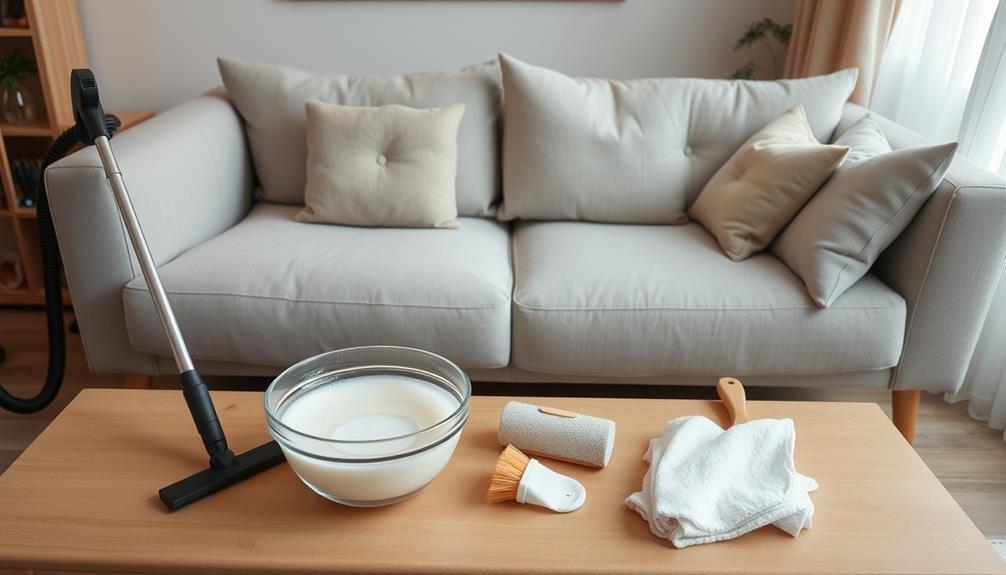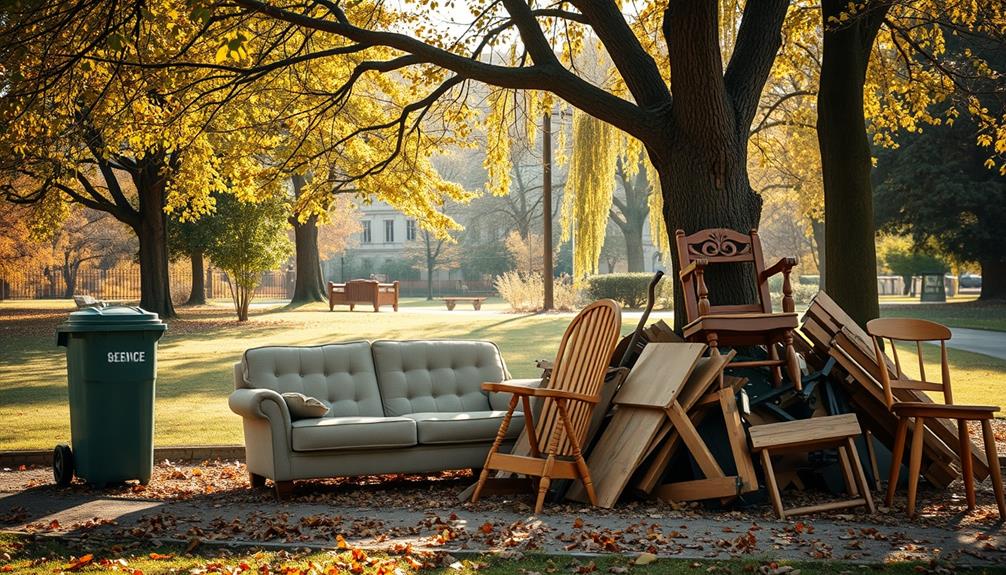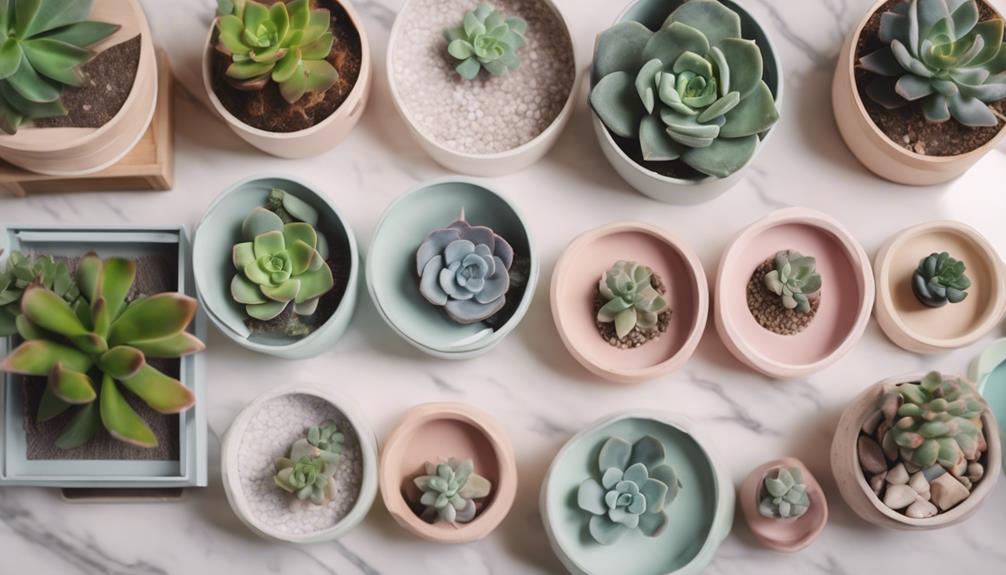To properly clean the cushions on your sofa, begin by checking the care labels for cleaning codes. Thoroughly vacuum both sides to eliminate dust and debris. If your cushions have removable covers, wash them on a delicate cycle with cold water and a dye-free detergent. For cushions that cannot be removed, prepare a mild cleaning solution and spot clean any stains, ensuring to rinse off any soap residue. Allow everything to air dry completely, while avoiding direct sunlight to prevent fading. By following these steps, your cushions will appear fresh and last longer. Looking for more advice on specific materials and techniques? For additional guidance on cleaning sofa cushions made of different materials, it may be helpful to consult a professional cleaner or search for specialized cleaning methods online. Furthermore, implementing regular maintenance like fluffing and rotating cushions can help prevent wear and tear. Adhering to these suggestions for cleaning sofa cushions will keep your furniture looking fantastic and ensure it remains in excellent condition for many years to come.
Key Takeaways
- Check the care labels on cushions for specific cleaning codes (W, S, WS, X) to choose the right cleaning method.
- Vacuum cushions thoroughly using an upholstery attachment to remove dust, debris, and pet hair.
- Spot clean stains with appropriate solutions, testing on inconspicuous areas first to avoid discoloration.
- For removable covers, follow care instructions for machine or hand washing, and air dry to prevent fading.
- Deep clean non-removable cushions by vacuuming, applying a gentle cleaning solution, and ensuring they are fully dry before use.
Understanding Cushion Types

When it comes to cleaning your sofa cushions, understanding the different types is essential for effective care. Each cushion material comes with specific cleaning codes that guide you on the best methods to use.
For instance, a "W" code means you can use water-based cleaners, while an "S" code indicates you should stick to solvent-based solutions. If your cushions carry a "WS" code, you're in luck—you can use both methods. However, "X" cushions require vacuuming only, so no liquids are allowed.
It's also important to take into account potential side effects and interactions of any cleaning agents used, similar to how one would approach cold medications for health concerns.
Natural fabrics like silk, linen, and cotton need gentler cleaning methods to avoid damage, whereas synthetic materials such as vinyl, polyester, and microfiber can usually handle stronger solutions.
Suede and leather, on the other hand, should typically be left to professionals to maintain their quality.
Essential Cleaning Supplies
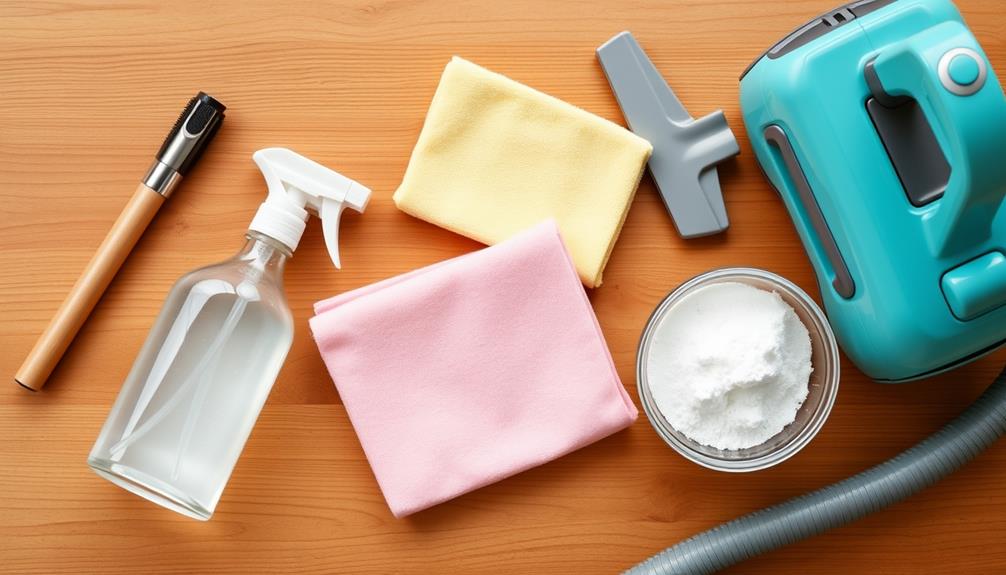
To effectively clean your sofa cushions, you'll need a few essential supplies.
Start with a vacuum cleaner equipped with upholstery attachments for removing dust and debris, as regular maintenance can extend the lifespan of your furniture, much like how preventive maintenance plans help appliances.
Have a light-colored cloth handy for spot cleaning. A mild detergent and towels will also be vital for deep cleaning and drying, ensuring your cushions look their best.
Recommended Cleaning Tools
Maintaining the cleanliness of your sofa cushions requires the right tools to guarantee effective results. Start with a vacuum cleaner equipped with an upholstery brush attachment. This tool is vital for effectively removing dust, pet hair, and debris from your cushions. Regular vacuuming keeps your sofa looking fresh and prevents dirt buildup.
Additionally, utilizing a professional cleaning service can help assure that your cushions receive a deep, thorough clean that may not be achievable through regular maintenance.
For a more thorough cleaning, consider investing in an upholstery cleaning machine. These machines are particularly useful for deep cleaning non-removable cushions, confirming that dirt and stains are properly extracted. When using these machines, a mild detergent is necessary to safely clean your cushions, especially for fabrics that respond well to water-based solutions.
During spot cleaning, light-colored cloths come in handy. They help you see transferred dirt and prevent color bleeding, assuring your cushions maintain their original hue.
Finally, don't forget towels! They're essential for drying any excess moisture after cleaning, which helps prevent mold growth and preserves the integrity of your cushion fabric.
With these recommended tools in hand, you'll be well on your way to spotless and fresh sofa cushions.
Necessary Cleaning Materials
Regularly gathering the right cleaning materials can make a significant difference in maintaining your sofa cushions. Here's a list of essential supplies you'll need to keep your cushions looking fresh and clean.
| Cleaning Material | Purpose |
|---|---|
| Vacuum Cleaner | Removes dirt and debris with upholstery brush and crevice tool attachments. |
| Mild Detergent | Safely cleans fabric fibers when diluted properly. |
| Light-Colored Cloths | Ideal for spot cleaning; prevents color transfer and highlights stains. |
| Towels | Absorb excess moisture post-cleaning, preventing mold growth. |
| Specialized Stain Removers | Helps tackle tough stains effectively. |
Having these materials on hand will guarantee you're well-equipped for any cleaning task. A vacuum cleaner helps you efficiently remove dust and debris, while a mild detergent is vital for safe, effective cleaning. Light-colored cloths are important for spotting stains without risking color transfer, and towels are necessary for drying your cushions thoroughly. Don't forget to take into account specialized stain removal products, as they can be lifesavers for those stubborn spots. With the right materials, you'll keep your sofa cushions looking their best!
Preparing for Cleaning

Before diving into the cleaning process, it's important to prepare your sofa cushions properly. Start by checking the care label on each cushion. You'll find a cleaning code—W, S, WS, or X—that indicates the proper cleaning methods for your specific fabric. This step guarantees you won't damage your cushions during the process.
Additionally, consider the air quality in your home while cleaning; using an air purifier can help eliminate allergens that may be stirred up during the cleaning process.
Next, gather your supplies. You'll need a vacuum cleaner with upholstery attachments, mild detergent, and towels for drying excess moisture. Once you have everything ready, remove the cushions from the sofa. This allows you to access all surfaces easily and assures a thorough cleaning.
Before applying any cleaning solutions, give the cushions a good vacuum. This helps eliminate loose dirt, hair, and debris, preparing them for deeper cleaning. If your cushions have removable cushion covers, it's a good idea to take them off and clean them separately, following the care instructions.
Lastly, always test any cleaning products on a small, inconspicuous area of the cushion first. This precaution guarantees that the cleaner won't cause discoloration or damage.
Now you're ready to proceed with the actual cleaning!
Vacuuming Sofa Cushions
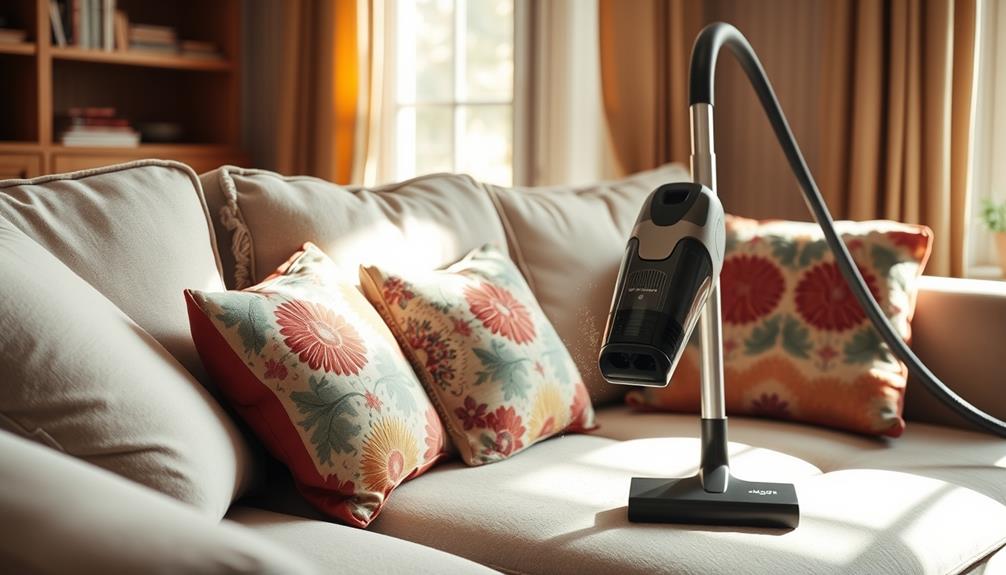
While vacuuming sofa cushions may seem like a simple task, it's vital for keeping them clean and extending their lifespan.
Begin by using a vacuum cleaner equipped with an upholstery brush attachment to effectively remove dust, hair, and debris. This attachment is designed to lift dirt without damaging the fabric, making it ideal for cleaning sofa cushions. Consider using one of the best vacuums for dust removal in 2024 to guarantee superior suction power and filtration.
Don't forget to tackle tight spaces and seams with a crevice tool. This guarantees you eliminate trapped dirt that can accumulate over time.
For removable cushions, be sure to vacuum both sides and flip them regularly. This not only helps maintain an even clean but also prolongs the cushions' lifespan.
To keep allergens and dirt at bay, schedule regular vacuuming sessions at least once a week. Consistency is key to maintaining a fresh and inviting sofa.
Finally, always check the manufacturer's care instructions to confirm that your vacuuming method is safe for the specific fabric type of your cushions.
Spot Cleaning Techniques

When it comes to spot cleaning your sofa cushions, knowing the right products and techniques makes all the difference.
Utilizing essential oils like lavender oil can also help create a calming environment while you clean.
You'll want to follow a specific stain removal process to tackle different materials effectively, and proper drying techniques are vital to prevent damage.
Let's explore these essential tips to keep your cushions looking fresh and clean.
Recommended Cleaning Products
Spot cleaning your sofa cushions requires the right products to tackle various stains effectively. For microfiber cushions, rubbing alcohol is one of the top recommended cleaning products; simply apply it with a light-colored sponge and scrub gently.
If you have fabric cushions, a mild detergent solution diluted in water works wonders, but always remember to test a small hidden area first to check for colorfastness. Exploring different coffee varieties can also enhance your cleaning experience, providing an invigorating boost while you work on those stains.
When dealing with organic stains, like food or pet urine, enzyme-based cleaners are ideal as they break down proteins, eliminating both odor and discoloration.
For leather cushions, act quickly—immediately wipe any spills with a soft cloth. For stubborn stains, use a damp cloth with mild soap, wiping from the center outward to prevent spreading.
Always keep a clean, light-colored cloth or paper towel handy to blot stains. This prevents further absorption into the fabric, making it easier to clean.
Stain Removal Process
Cleaning stains from your sofa cushions can feel challenging, but using the right techniques makes it manageable. Understanding the materials of your cushions is essential, as different fabrics require different care methods. The stain removal process starts with the right approach depending on your cushion material.
Here's how to tackle common stains effectively:
- Microfiber cushions: Apply rubbing alcohol to a light-colored sponge and gently scrub the stained area, working in small sections for the best results. The unique properties of microfiber can help lift stains without damaging the fabric, making it a popular choice for many households.
- Leather cushions: Immediately blot spills with a soft cloth. For stains, dampen the cloth and wipe from the center outward to prevent spreading. Regular maintenance, such as using a leather conditioner, can also help prevent future stains and preserve the material.
- Coffee stains: Mix water with mild detergent, then blot the stain with this solution, making certain you avoid excessive moisture to protect the fabric. Remember, various brewing methods can lead to different coffee stain challenges, so it's good to know how to address them.
- Red wine stains: Quickly blot with a clean cloth, then apply a vinegar-water solution, followed by a warm water-salt mixture to lift the stain.
- Spot test: Always test any cleaning solution on a hidden area of the fabric first to verify colorfastness and avoid potential damage.
Drying Techniques After Cleaning
After tackling those stubborn stains, drying your sofa cushions properly is the next step to confirm they stay in good condition. To prevent mold and mildew growth, always allow your cushions to air dry completely in a well-ventilated area. Utilizing fans can enhance air circulation around the damp cushions, greatly reducing drying time.
Here's a quick guide to help you through the drying process:
| Method | Pros | Cons |
|---|---|---|
| Air Dry | Natural method, safe for all fabrics | Takes longer, especially in humidity |
| Use a Fan | Increases air circulation, reduces time | Noise can be distracting |
| Dehumidifier | Extracts moisture, ideal in humid areas | Requires electricity, adds cost |
| Avoid Direct Sunlight | Prevents fading and damage | Slower drying time |
Periodically check your cushions during the drying process to confirm they dry evenly and are free from residual moisture. Avoid placing cleaned cushions in direct sunlight, as it can cause the fabric colors to fade over time. With these techniques, you'll have your sofa cushions dry and ready for use in no time!
Washing Removable Covers
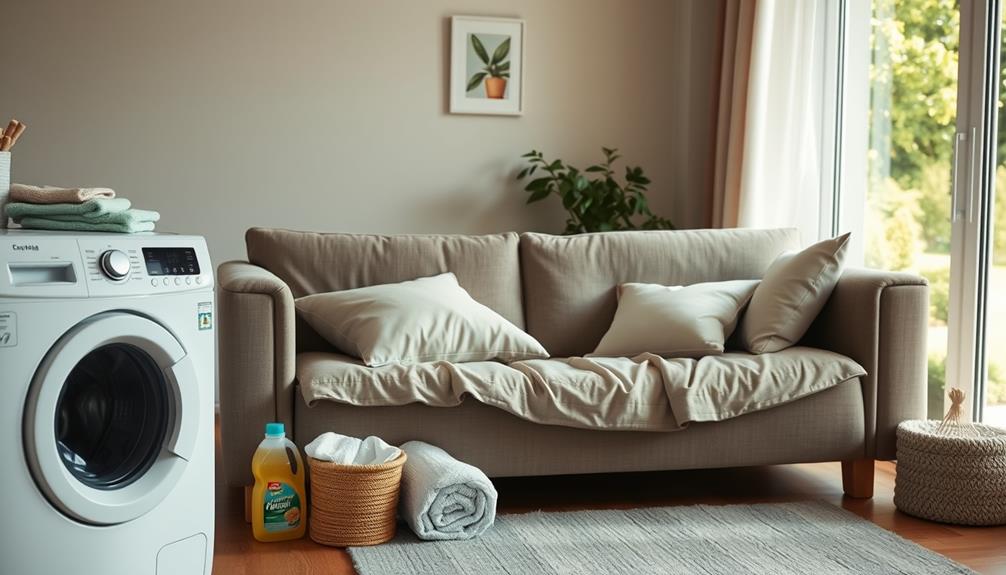
When you want to freshen up your sofa, washing the removable covers is a great place to start. First, check the care label to see if they can go in the washing machine. Following the specific instructions is essential to avoid any mishaps, similar to how budgeting helps manage expenses.
Here's what you should do:
- Use a gentle cycle with dye-free detergent and cold water.
- If they're not machine washable, hand wash them in a tub with cool water and detergent.
- Rinse thoroughly to make sure all soap residues are removed.
- Air dry the covers in a shaded area or indoors; avoid direct sunlight to prevent fading.
- Confirm the covers are completely dry before putting them back on the cushions to avoid mold and mildew.
Taking these steps will help keep your removable covers looking fresh and vibrant. Remember, always handle them with care, and your sofa will thank you for it!
Cleaning Non-Removable Cushions
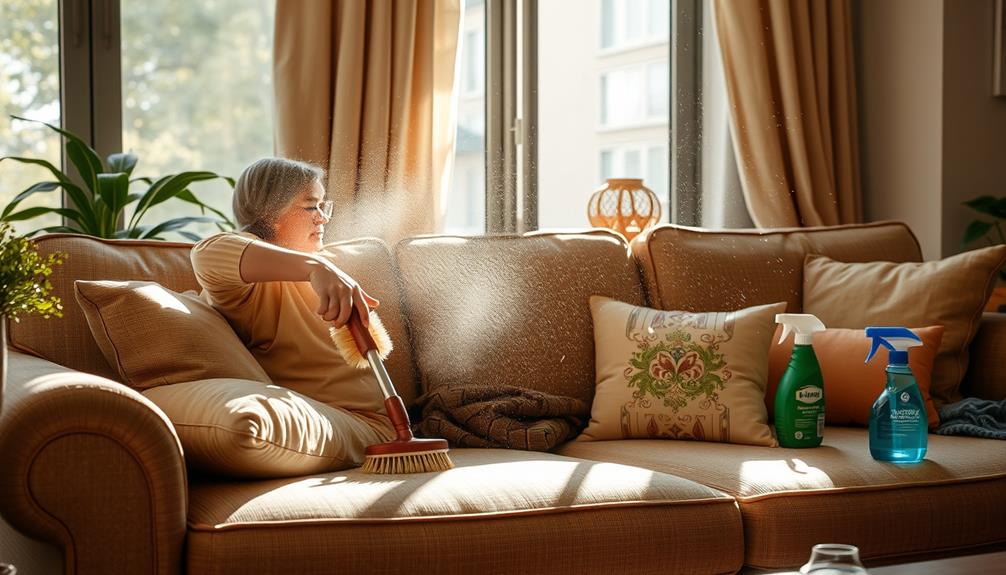
When you're cleaning non-removable cushions, start by vacuuming them thoroughly to eliminate dust and debris.
This step is essential for maintaining the overall cleanliness of your living space and preventing allergens from accumulating.
Next, mix a gentle cleaning solution and apply it carefully with an upholstery brush, making sure not to soak the fabric.
This method helps keep your cushions fresh without risking water damage, ensuring they remain in great condition for years to come.
You might also consider best room fans for summer cooling to improve air circulation while cleaning.
Vacuum and Spot Clean
Cleaning non-removable sofa cushions can feel challenging, but with a few simple steps, you can keep them looking fresh.
Start by thoroughly vacuuming the cushions using a vacuum with an upholstery attachment. This helps remove dust, pet hair, and debris that can accumulate over time.
Next, spot clean any visible stains. Here's how:
- Mix warm water with ½ teaspoon of dye-free dish soap.
- Apply the solution gently with an upholstery brush on the stained areas.
- Avoid soaking the fabric; instead, use a damp cloth to wipe down cleaned areas.
- Make sure to remove any soap residue after treating stains.
- Allow the cushions to dry completely before using them again.
Regularly vacuuming and spot cleaning your non-removable cushions will help maintain their appearance and prolong their lifespan.
Remember, sitting on damp cushions can lead to mold and mildew growth, so confirm they're fully dry before lounging.
Cleaning Solution Application
Applying a cleaning solution effectively is vital for maintaining the appearance of non-removable sofa cushions.
First, vacuum the fabric thoroughly to eliminate surface dirt and debris. Once that's done, mix a solution of warm water and ½ teaspoon of dye-free dish soap, ensuring it's well combined.
Use an upholstery brush for the cleaning solution application, as it allows for better control. When applying the solution, be careful not to soak the material; too much water can lead to water damage.
Gently scrub the fabric in a circular motion, focusing on any stained areas. After cleaning your sofa, take a damp cloth and wipe down the fabric to remove any soap residue.
This step is important, as leftover soap can attract dirt and create more mess.
Deep-Cleaning Foam Cushions
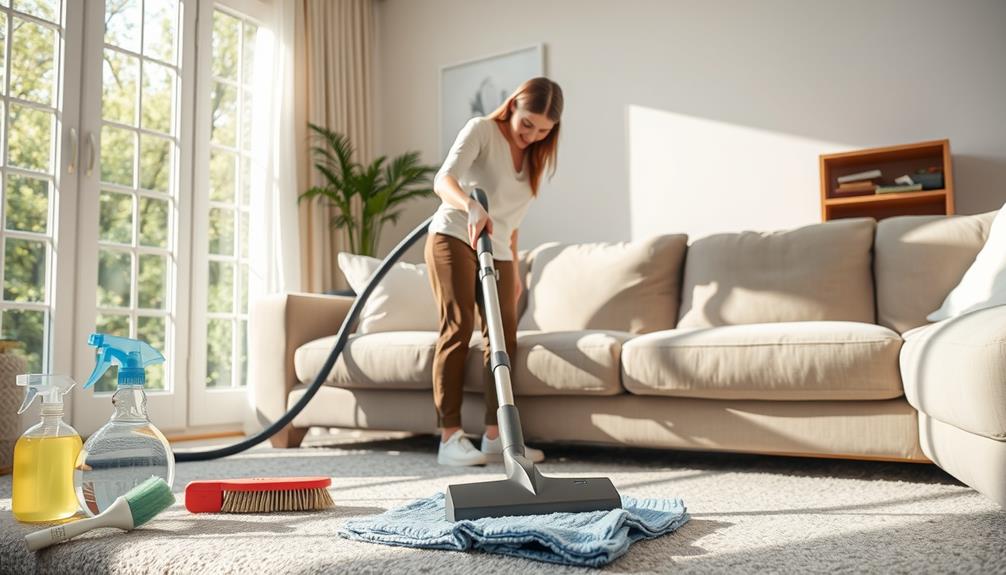
Deep-cleaning foam cushions can breathe new life into your furniture and keep it looking fresh. To get started, follow these simple steps for effective cleaning.
- Spot clean any stains using a warm, soapy water solution and a soft cloth. Be careful not to soak the foam.
- Hand wash the foam by soaking it in a tub filled with laundry detergent and cool water. Gently agitate the foam to remove dirt.
- Rinse thoroughly with clean water to eliminate all soap residue. For added freshness, follow up with a rinse of cold water mixed with vinegar.
- Allow the foam cushions to air dry completely in a well-ventilated area. Avoid direct sunlight, as it can damage the material.
- Ensure the foam is completely dry before placing it back in the cushions. This step is essential to prevent mold and mildew growth.
Drying and Maintaining Cushions

After washing your sofa cushions, proper drying is vital to maintain their integrity and prevent mold or mildew. First, allow your cushions to air dry completely before reassembling them. This step is significant; any residual moisture can lead to unwanted growth.
If you're in a humid environment, consider using fans or dehumidifiers to promote air circulation and speed up the drying process.
Be cautious about direct sunlight during drying, as it can fade fabric colors. Instead, find a shaded area where air can flow freely. While your cushions dry, regularly inspect them to confirm they're moisture-free. If you notice any damp spots, address them immediately to avoid issues down the line.
Once your cushions are dry, it's time to fluff them up. This action helps restore their shape and comfort, confirming they're ready for everyday use.
Keeping your cushions well-maintained not only enhances their appearance but also prolongs their lifespan. With these drying tips, you're on your way to enjoying fresh and cozy sofa cushions that stay in great condition for years to come.
Tips for Regular Care

Maintaining your sofa cushions doesn't stop once they're dry; regular care is key to keeping them looking and feeling great.
By implementing a few simple habits, you can guarantee your cushions remain in top condition.
- Vacuum regularly: Aim to vacuum your sofa cushions at least once a week to remove dust, hair, and debris. This prevents buildup that can degrade fabric quality.
- Spot clean spills immediately: Don't let spills sit. Use a mild detergent or the appropriate cleaner based on your cushion's fabric care code to avoid staining and damage.
- Rotate and flip cushions: Every few months, make it a habit to rotate and flip your removable cushions. This promotes even wear and helps maintain their shape.
- Schedule deep cleaning: Plan for a thorough cleaning every 6-12 months, especially if you have pets. This guarantees sanitation and prolongs the life of your cushions.
- Use protective covers: Consider investing in protective covers to shield your cushions from dirt, spills, and UV light, making regular cleaning easier.
With these tips, you'll keep your sofa cushions fresh and inviting for years to come!
Frequently Asked Questions
What Is the Best Way to Clean Couch Cushions?
To clean couch cushions effectively, check the care tag for instructions. Vacuum thoroughly, spot clean with mild detergent, or wash removable covers on a gentle cycle. Regular maintenance will keep your cushions looking fresh and inviting.
How Do You Wash Cushions That Cannot Be Washed?
When you've got non-washable cushions, vacuum them thoroughly first. Spot clean stains with a mild soap solution, and consider using an upholstery cleaner. If they're heavily soiled, you might want to hire a professional.
Should Couch Cushions Be Washed Inside Out?
You wouldn't believe how much dirt hides in cushion covers! Yes, you should wash couch cushions inside out. It protects fabric, reduces fading, and guarantees a deeper clean, keeping allergens at bay. Just secure those zippers!
How to Clean Sofa Foam Cushions?
To clean foam cushions, you'll spot clean with warm water and mild detergent, rinse thoroughly, or soak them in a diluted detergent solution. Finish by treating with vinegar and air dry in a ventilated area.
Conclusion
By following these steps, you can keep your sofa cushions looking fresh and inviting. Remember, a little maintenance goes a long way—don't let dirt and stains get the best of your furniture. Regular vacuuming and spot cleaning can help you stay ahead of the game. So, roll up your sleeves and give those cushions some love; you'll be glad you did when your living space feels like a cozy retreat.
